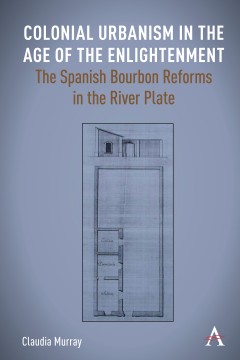Colonial Urbanism in the Age of the Enlightenment
The Spanish Bourbon Reforms in the River Plate
By Claudia Murray
Other Formats Available:
- About This Book
- Reviews
- Author Information
- Series
- Table of Contents
- Links
- Podcasts
About This Book
During the eighteenth century, the Bourbon monarchy set about making geopolitical changes in the colonies in order to encourage trade. Buenos Aires was designated as the new capital city of the Viceroyalty of the River Plate in 1776. However, the city had at the time very little urban infrastructure – it did not even have a cathedral or appropriate government buildings to welcome high-ranked bureaucrats from Spain, such as the Viceroy. Streets were mainly unpaved, dusty and there were no parks or promenades like in other capitals, where the eighteenth-century society could parade in fine clothes and displayed their often newly acquired social status.
This book tells the story of how the monarchy aimed at creating a new capital city in a remote and forgotten area of the empire. It also shows how the local Creole bourgeoisie rapidly assumed the role of urban developers, and enhanced their economic status by investing in and controlling the Buenos Aires’ property market. In a short period, from 1776 to 1810, the urban transformation of Buenos Aires helped increase the Crown’s revenues and considerably reduced contraband trade. Nevertheless, urban changes generated an internal struggle for power for the control of the city between the Spanish loyalist and the local wealthier Creoles. As this book concludes, for an empire such as the Spanish, which was constructed upon a network of cities, the Crown’s loss of the control of Buenos Aires’ urban space was a serious threat to its power that foreshadowed Argentina’s wars of independence.
Reviews
“Written in a clear engaging way and beautifully illustrated, this excellent original scholarly study of Buenos Aires in the late eighteenth century based on archival research not only adds greatly to our knowledge of the history of urban planning and architecture in Latin America but also reveals new thinking about how societies were seeking to reflect their status on the eve of independence.” — Linda Newson, Emeritus Professor, Centre for Latin American and Caribbean Studies, University of London, UK.
“This book presents a compelling account of the material and urban impacts of ‘enlightened’ reform in the late eighteenth-century viceroyalty of the Río de la Plata, especially in the city of Buenos Aires. The author’s archival research and use of theoretical frameworks for understanding the Enlightenment, including those of Max Weber, Michel Foucault, Theodoro Adorno and Max Horkheimer, allow for critical interpretation that should be of interest to the fields of Latin American urban history and geography.” — Paul B. Niell, Ph.D., Clark Professor, Clark Library and Center for 17th and 18th Century Studies, University of California, Los Angeles, USA.
Author Information
Claudia Murray is a research fellow at the School of Real Estate and Planning, University of Reading. Her research interests focus on the socio-cultural and economic implications of rural and urban development of the built environment.
Series
Anthem Studies in Latin American Literature and Culture
Table of Contents
List of Figures and Tables; Acknowledgements; Introduction; 1. The Spanish Empire before the Bourbon Reforms; 2. The River Plate before 1776 and the Bourbon Reforms; 3. Urban Expansion; 4. The Image of Power; 5. Ceremonies of Power; 6. Disciplining Porteños’ Private Architecture; 7. The British Assault on the River Plate; Appendix 1; Bibliography; Index
Links
Stay Updated
Information
Latest Tweets



